Hydroxychloroquine Mitigates Dilated Cardiomyopathy Phenotype in Transgenic D94A Mice
Abstract
1. Introduction
2. Results
2.1. Effect of HCQ Administration on the in vivo Heart Function
2.2. Effect of HCQ Treatment on Gross Morphology, Histopathology, and Ultrastructure
2.3. Gene Expression Profiles in HCQ- vs. Placebo-Treated Tg-D94A and NTg Hearts
2.4. Contractile Function in Skinned Papillary Muscle Strips from HCQ vs. Placebo-Treated Tg-D94A and NTg Mice
2.5. The Effect of HCQ on the Super-Relaxed State of Myosin in HCQ vs. Placebo-Treated Tg-D94A and NTg Mice
3. Discussion
4. Materials and Methods
4.1. Transgenic Mice
4.2. Experimental Protocol and Treatment with Hydroxychloroquine (HCQ)
4.3. In Vivo Assessment of Cardiac Function
4.3.1. Echocardiography
4.3.2. Invasive Hemodynamics
4.4. Morphometric, Histological, and Ultrastructure Assessments
4.4.1. Histological Assessment
4.4.2. Assessment of Fibrosis by Hydroxyproline (HOP) Assay
4.4.3. Transmission Electron Microscopy (TEM)
4.5. Assessment of Gene Expression Profiles in the Hearts of HCQ- vs. Placebo-Treated Mice
4.6. Mechanical Measurements on Skinned Papillary Muscle Fibers
4.6.1. Preparation of Fibers
4.6.2. Assessment of Maximal Contractile Force and Force-pCa in Skinned LVPM Strips
4.7. Single ATP Turnover Rate Measurements in Skinned LVPM Fibers
4.8. Statistical Analysis
Supplementary Materials
Author Contributions
Funding
Institutional Review Board Statement
Informed Consent Statement
Data Availability Statement
Acknowledgments
Conflicts of Interest
Abbreviations
| ACE2 | angiotensin-converting enzyme 2 |
| ANF | atrial natriuretic factor |
| A wave | mitral valve inflow (late) |
| B-mode | brightness mode |
| BNP | B-type natriuretic peptide |
| DCM | dilated cardiomyopathy |
| DRX | disordered relaxed state |
| ECG | Electrocardiogram |
| E wave | mitral valve inflow (early) |
| Ea | arterial elastance |
| Ees | end-systolic elastance |
| EF | ejection fraction |
| ESPVR | end-systolic pressure-volume relationship |
| FS | fractional shortening |
| HCQ | hydroxychloroquine |
| LV | left ventricle |
| LVPM | LV papillary muscles |
| LVPW | LV posterior wall |
| M-mode | time-motion display of the ultrasound wave |
| Mant-ATP | fluorescent (N-methylanthraniloyl) analog of ATP |
| NTg | non-transgenic |
| P1 | amplitude of fast DRX phase |
| P2 | amplitude of slow SRX phase |
| P-V loops | Pressure-Volume hemodynamic measurements |
| RV | right ventricle |
| SRX | super-relaxed state |
| T1 | nucleotide turnover lifetime in DRX |
| T2 | nucleotide turnover lifetime in SRX |
| TEM | transmission electron microscopy |
| Tg | transgenic |
References
- Wang, N.; Han, S.; Liu, R.; Meng, L.; He, H.; Zhang, Y.; Wang, C.; Lv, Y.; Wang, J.; Li, X.; et al. Chloroquine and hydroxychloroquine as ACE2 blockers to inhibit viropexis of 2019-nCoV Spike pseudotyped virus. Phytomedicine Int. J. Phytother. PhytoPharm. 2020, 79, 153333. [Google Scholar] [CrossRef] [PubMed]
- Chen, C.Y.; Wang, F.L.; Lin, C.C. Chronic hydroxychloroquine use associated with QT prolongation and refractory ventricular arrhythmia. Clin. Toxicol. 2006, 44, 173–175. [Google Scholar] [CrossRef] [PubMed]
- Joyce, E.; Fabre, A.; Mahon, N. Hydroxychloroquine cardiotoxicity presenting as a rapidly evolving biventricular cardiomyopathy: Key diagnostic features and literature review. Eur. Heart J. Acute Cardiovasc. Care 2013, 2, 77–83. [Google Scholar] [CrossRef] [PubMed]
- Prodromos, C.C.; Rumschlag, T.; Perchyk, T. Hydroxychloroquine is protective to the heart, not harmful: A systematic review. New Microbes New Infect. 2020, 37, 100747. [Google Scholar] [CrossRef] [PubMed]
- Iglesias Cubero, G.; Rodriguez Reguero, J.J.; Rojo Ortega, J.M. Restrictive cardiomyopathy caused by chloroquine. Br. Heart J. 1993, 69, 451–452. [Google Scholar] [CrossRef]
- Yuan, C.C.; Kazmierczak, K.; Liang, J.; Zhou, Z.; Yadav, S.; Gomes, A.V.; Irving, T.C.; Szczesna-Cordary, D. Sarcomeric perturbations of myosin motors lead to dilated cardiomyopathy in genetically modified MYL2 mice. Proc. Natl. Acad. Sci. USA 2018, 115, E2338–E2347. [Google Scholar] [CrossRef]
- Yuan, C.C.; Kazmierczak, K.; Liang, J.; Ma, W.; Irving, T.C.; Szczesna-Cordary, D. Molecular basis of force-pCa relation in MYL2 cardiomyopathy mice: Role of the super-relaxed state of myosin. Proc. Natl. Acad. Sci. USA 2022, 119, e2110328119. [Google Scholar] [CrossRef]
- Huang, W.; Liang, J.; Yuan, C.C.; Kazmierczak, K.; Zhou, Z.; Morales, A.; McBride, K.L.; Fitzgerald-Butt, S.M.; Hershberger, R.E.; Szczesna-Cordary, D. Novel familial dilated cardiomyopathy mutation in MYL2 affects the structure and function of myosin regulatory light chain. FEBS J. 2015, 282, 2379–2393. [Google Scholar] [CrossRef]
- Garfinkel, A.C.; Seidman, J.G.; Seidman, C.E. Genetic Pathogenesis of Hypertrophic and Dilated Cardiomyopathy. Heart Fail. Clin. 2018, 14, 139–146. [Google Scholar] [CrossRef]
- Pinto, Y.M.; Elliott, P.M.; Arbustini, E.; Adler, Y.; Anastasakis, A.; Bohm, M.; Duboc, D.; Gimeno, J.; de Groote, P.; Imazio, M.; et al. Proposal for a revised definition of dilated cardiomyopathy, hypokinetic non-dilated cardiomyopathy, and its implications for clinical practice: A position statement of the ESC working group on myocardial and pericardial diseases. Eur. Heart J. 2016, 37, 1850–1858. [Google Scholar] [CrossRef]
- McNally, E.M.; Mestroni, L. Dilated Cardiomyopathy: Genetic Determinants and Mechanisms. Circ. Res. 2017, 121, 731–748. [Google Scholar] [CrossRef] [PubMed]
- Lopez-Ruiz, N.; Uribe, C.E. Chloroquine cardiomyopathy: Beyond ocular adverse effects. BMJ Case Rep. 2014, 2014. [Google Scholar] [CrossRef] [PubMed]
- Yuan, C.C.; Muthu, P.; Kazmierczak, K.; Liang, J.; Huang, W.; Irving, T.C.; Kanashiro-Takeuchi, R.M.; Hare, J.M.; Szczesna-Cordary, D. Constitutive phosphorylation of cardiac myosin regulatory light chain prevents development of hypertrophic cardiomyopathy in mice. Proc. Natl. Acad. Sci. USA 2015, 112, E4138–E4146. [Google Scholar] [CrossRef] [PubMed]
- Dulce, R.A.; Kanashiro-Takeuchi, R.M.; Takeuchi, L.M.; Salerno, A.G.; Wanschel, A.; Kulandavelu, S.; Balkan, W.; Zuttion, M.; Cai, R.; Schally, A.V.; et al. Synthetic growth hormone-releasing hormone agonist ameliorates the myocardial pathophysiology characteristic of HFpEF. Cardiovasc. Res. 2022, cvac098. [Google Scholar] [CrossRef] [PubMed]
- Monge García, M.I.; Santos, A. Understanding ventriculo-arterial coupling. Ann. Transl. Med. 2020, 8, 795. [Google Scholar] [CrossRef]
- Yuan, C.C.; Kazmierczak, K.; Liang, J.; Kanashiro-Takeuchi, R.; Irving, T.C.; Gomes, A.V.; Wang, Y.; Burghardt, T.P.; Szczesna-Cordary, D. Hypercontractile mutant of ventricular myosin essential light chain leads to disruption of sarcomeric structure and function and results in restrictive cardiomyopathy in mice. Cardiovasc. Res. 2017, 113, 1124–1136. [Google Scholar] [CrossRef] [PubMed]
- Essien, E.E.; Ette, E.I. Effects of chloroquine and didesethylchloroquine on rabbit myocardium and mitochondria. J. Pharm. Pharm. 1986, 38, 543–546. [Google Scholar] [CrossRef] [PubMed]
- Chaanine, A.H.; Gordon, R.E.; Nonnenmacher, M.; Kohlbrenner, E.; Benard, L.; Hajjar, R.J. High-dose chloroquine is metabolically cardiotoxic by inducing lysosomes and mitochondria dysfunction in a rat model of pressure overload hypertrophy. Physiol. Rep. 2015, 3, e12413. [Google Scholar] [CrossRef]
- Li, W.; Moore, M.J.; Vasilieva, N.; Sui, J.; Wong, S.K.; Berne, M.A.; Somasundaran, M.; Sullivan, J.L.; Luzuriaga, K.; Greenough, T.C.; et al. Angiotensin-converting enzyme 2 is a functional receptor for the SARS coronavirus. Nature 2003, 426, 450–454. [Google Scholar] [CrossRef]
- Goulter, A.B.; Goddard, M.J.; Allen, J.C.; Clark, K.L. ACE2 gene expression is up-regulated in the human failing heart. BMC Med. 2004, 2, 19. [Google Scholar] [CrossRef]
- Hara, Y.; Hamada, M.; Ohtsuka, T.; Ogimoto, A.; Saeki, H.; Matsunaka, T.; Suzuki, J.; Shigematsu, Y. Comparison of treatment effects of bevantolol and metoprolol on cardiac function and natriuretic peptides in patients with dilated cardiomyopathy. Heart Vessel. 2002, 17, 53–56. [Google Scholar] [CrossRef] [PubMed]
- Tsutamoto, T.; Wada, A.; Maeda, K.; Hisanaga, T.; Maeda, Y.; Fukai, D.; Ohnishi, M.; Sugimoto, Y.; Kinoshita, M. Attenuation of compensation of endogenous cardiac natriuretic peptide system in chronic heart failure: Prognostic role of plasma brain natriuretic peptide concentration in patients with chronic symptomatic left ventricular dysfunction. Circulation 1997, 96, 509–516. [Google Scholar] [CrossRef] [PubMed]
- Jeffrey, D.A.; Pires Da Silva, J.; Garcia, A.M.; Jiang, X.; Karimpour-Fard, A.; Toni, L.S.; Lanzicher, T.; Peña, B.; Miyano, C.A.; Nunley, K.; et al. Serum circulating proteins from pediatric patients with dilated cardiomyopathy cause pathologic remodeling and cardiomyocyte stiffness. JCI Insight 2021, 6, e148637. [Google Scholar] [CrossRef] [PubMed]
- Alehagen, U.; Dahlstrom, U. Can NT-proBNP predict risk of cardiovascular mortality within 10 years? Results from an epidemiological study of elderly patients with symptoms of heart failure. Int. J. Cardiol. 2009, 133, 233–240. [Google Scholar] [CrossRef] [PubMed][Green Version]
- Tsutamoto, T.; Wada, A.; Maeda, K.; Hisanaga, T.; Fukai, D.; Maeda, Y.; Ohnishi, M.; Mabuchi, N.; Kinoshita, M. Digitalis increases brain natriuretic peptide in patients with severe congestive heart failure. Am. Heart J. 1997, 134 Pt 1, 910–916. [Google Scholar] [CrossRef]
- Gil-Cayuela, C.; Rosello, L.E.; Ortega, A.; Tarazon, E.; Trivino, J.C.; Martinez-Dolz, L.; Gonzalez-Juanatey, J.R.; Lago, F.; Portoles, M.; Rivera, M. New Altered Non-Fibrillar Collagens in Human Dilated Cardiomyopathy: Role in the Remodeling Process. PLoS ONE 2016, 11, e0168130. [Google Scholar] [CrossRef]
- Giudicessi, J.R.; Noseworthy, P.A.; Friedman, P.A.; Ackerman, M.J. Urgent Guidance for Navigating and Circumventing the QTc-Prolonging and Torsadogenic Potential of Possible Pharmacotherapies for Coronavirus Disease 19 (COVID-19). Mayo Clin. Proc. 2020, 95, 1213–1221. [Google Scholar] [CrossRef]
- Hooijman, P.; Stewart, M.A.; Cooke, R. A new state of cardiac Myosin with very slow ATP turnover: A potential cardioprotective mechanism in the heart. Biophys. J. 2011, 100, 1969–1976. [Google Scholar] [CrossRef]
- Alamo, L.; Ware, J.S.; Pinto, A.; Gillilan, R.E.; Seidman, J.G.; Seidman, C.E.; Padron, R. Effects of myosin variants on interacting-heads motif explain distinct hypertrophic and dilated cardiomyopathy phenotypes. Elife 2017, 6, e24634. [Google Scholar] [CrossRef]
- Sitbon, Y.H.; Kazmierczak, K.; Liang, J.; Yadav, S.; Veerasammy, M.; Kanashiro-Takeuchi, R.M.; Szczesna-Cordary, D. Ablation of the N terminus of cardiac essential light chain promotes the super-relaxed state of myosin and counteracts hypercontractility in hypertrophic cardiomyopathy mutant mice. FEBS J. 2020, 287, 3989–4004. [Google Scholar] [CrossRef]
- Yadav, S.; Kazmierczak, K.; Liang, J.; Sitbon, Y.H.; Szczesna-Cordary, D. Phosphomimetic-mediated in vitro rescue of hypertrophic cardiomyopathy linked to R58Q mutation in myosin regulatory light chain. FEBS J. 2019, 286, 151–168. [Google Scholar] [CrossRef] [PubMed]
- Krishnasamy, R.; Isbel, N.M.; Hawley, C.M.; Pascoe, E.M.; Burrage, M.; Leano, R.; Haluska, B.A.; Marwick, T.H.; Stanton, T. Left Ventricular Global Longitudinal Strain (GLS) Is a Superior Predictor of All-Cause and Cardiovascular Mortality When Compared to Ejection Fraction in Advanced Chronic Kidney Disease. PLoS ONE 2015, 10, e0127044. [Google Scholar] [CrossRef]
- Zhu, Z.; Godana, D.; Li, A.; Rodriguez, B.; Gu, C.; Tang, H.; Minshall, R.D.; Huang, W.; Chen, J. Echocardiographic assessment of right ventricular function in experimental pulmonary hypertension. Pulm. Circ. 2019, 9, 2045894019841987. [Google Scholar] [CrossRef] [PubMed]
- Bourke, L.; McCormick, J.; Taylor, V.; Pericleous, C.; Blanchet, B.; Costedoat-Chalumeau, N.; Stuckey, D.; Lythgoe, M.F.; Stephanou, A.; Ioannou, Y. Hydroxychloroquine Protects against Cardiac Ischaemia/Reperfusion Injury In Vivo via Enhancement of ERK1/2 Phosphorylation. PLoS ONE 2015, 10, e0143771. [Google Scholar] [CrossRef] [PubMed]
- Le, N.-T.; Takei, Y.; Izawa-Ishizawa, Y.; Heo, K.-S.; Lee, H.; Smrcka, A.V.; Miller, B.L.; Ko, K.A.; Ture, S.; Morrell, C.; et al. Identification of Activators of ERK5 Transcriptional Activity by High-Throughput Screening and the Role of Endothelial ERK5 in Vasoprotective Effects Induced by Statins and Antimalarial Agents. J. Immunol. 2014, 193, 3803–3815. [Google Scholar] [CrossRef]
- Capel, R.A.; Herring, N.; Kalla, M.; Yavari, A.; Mirams, G.R.; Douglas, G.; Bub, G.; Channon, K.; Paterson, D.J.; Terrar, D.A.; et al. Hydroxychloroquine reduces heart rate by modulating the hyperpolarization-activated current If: Novel electrophysiological insights and therapeutic potential. Heart Rhythm. 2015, 12, 2186–2194. [Google Scholar] [CrossRef]
- Wang, Y.; Xu, Y.; Kerrick, W.G.L.; Wang, Y.; Guzman, G.; Diaz-Perez, Z.; Szczesna-Cordary, D. Prolonged Ca2+ and force transients in myosin RLC transgenic mouse fibers expressing malignant and benign FHC mutations. J. Mol. Biol. 2006, 361, 286–299. [Google Scholar] [CrossRef]
- Tang, T.T.; Lv, L.L.; Pan, M.M.; Wen, Y.; Wang, B.; Li, Z.L.; Wu, M.; Wang, F.M.; Crowley, S.D.; Liu, B.C. Hydroxychloroquine attenuates renal ischemia/reperfusion injury by inhibiting cathepsin mediated NLRP3 inflammasome activation. Cell Death Dis. 2018, 9, 351. [Google Scholar] [CrossRef] [PubMed]
- Kazmierczak, K.; Paulino, E.C.; Huang, W.; Muthu, P.; Liang, J.; Yuan, C.C.; Rojas, A.I.; Hare, J.M.; Szczesna-Cordary, D. Discrete effects of A57G-myosin essential light chain mutation associated with familial hypertrophic cardiomyopathy. Am. J. Physiol. Heart Circ. Physiol. 2013, 305, H575–H589. [Google Scholar] [CrossRef]
- Kazmierczak, K.; Xu, Y.; Jones, M.; Guzman, G.; Hernandez, O.M.; Kerrick, W.G.L.; Szczesna-Cordary, D. The Role of the N-Terminus of the Myosin Essential Light Chain in Cardiac Muscle Contraction. J. Mol. Biol. 2009, 387, 706–725. [Google Scholar] [CrossRef][Green Version]
- Huang, W.; Liang, J.; Kazmierczak, K.; Muthu, P.; Duggal, D.; Farman, G.P.; Sorensen, L.; Pozios, I.; Abraham, T.; Moore, J.R.; et al. Hypertrophic Cardiomyopathy Associated Lys104Glu Mutation in the Myosin Regulatory Light Chain Causes Diastolic Disturbance in Mice. J. Mol. Cell Cardiol. 2014, 74, 318–329. [Google Scholar] [CrossRef] [PubMed]
- Kazmierczak, K.; Yuan, C.-C.; Liang, J.; Huang, W.; Rojas, A.I.; Szczesna-Cordary, D. Remodeling of the heart in hypertrophy in animal models with myosin essential light chain mutations. Front. Physiol. 2014, 5, 353. [Google Scholar] [CrossRef] [PubMed]
- Kazmierczak, K.; Muthu, P.; Huang, W.; Jones, M.; Wang, Y.; Szczesna-Cordary, D. Myosin Regulatory Light Chain Mutation Found In Hypertrophic Cardiomyopathy Patients Increases Isometric Force Production in Transgenic Mice. Biochem. J. 2012, 442, 95–103. [Google Scholar] [CrossRef] [PubMed]
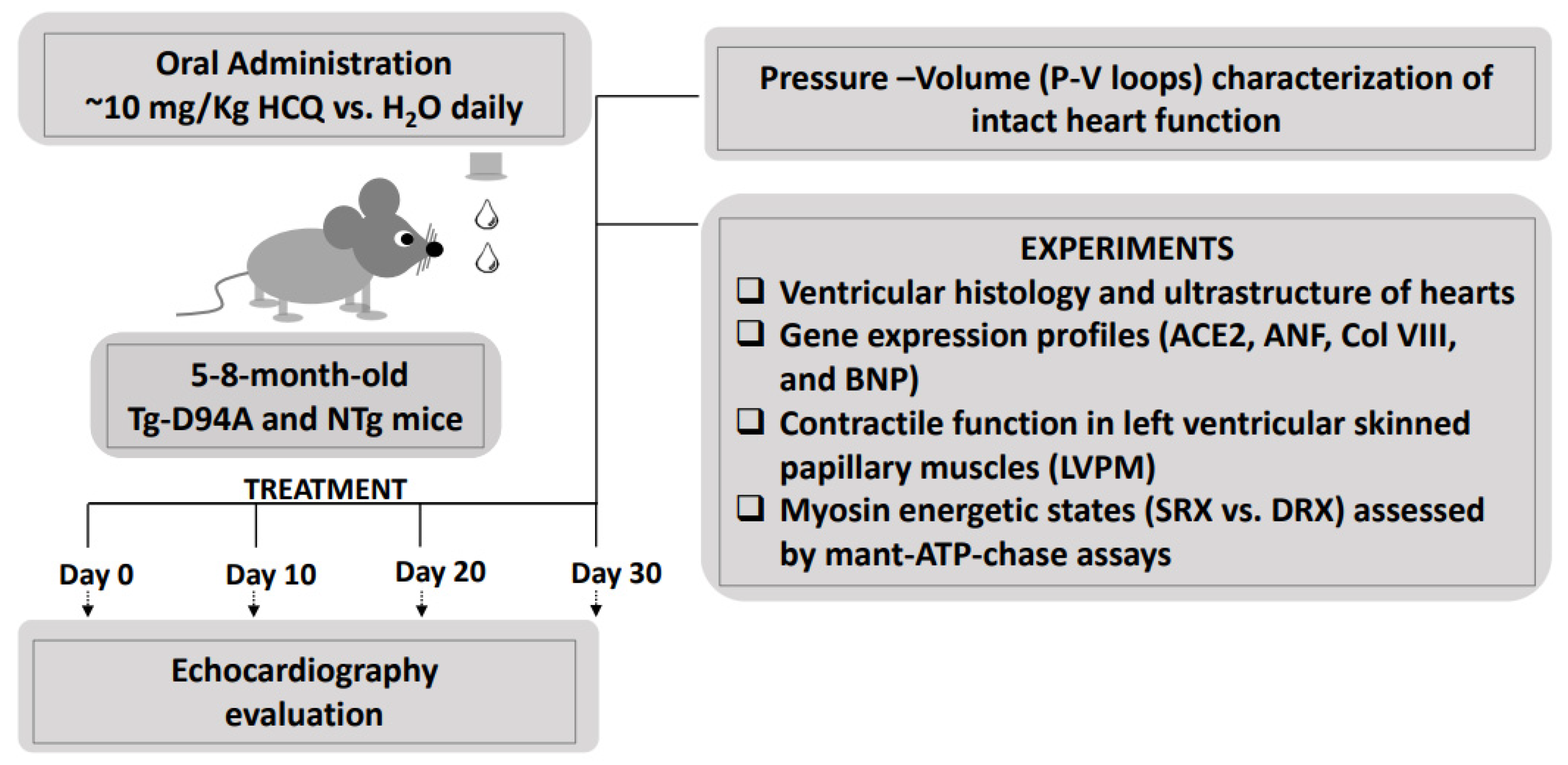


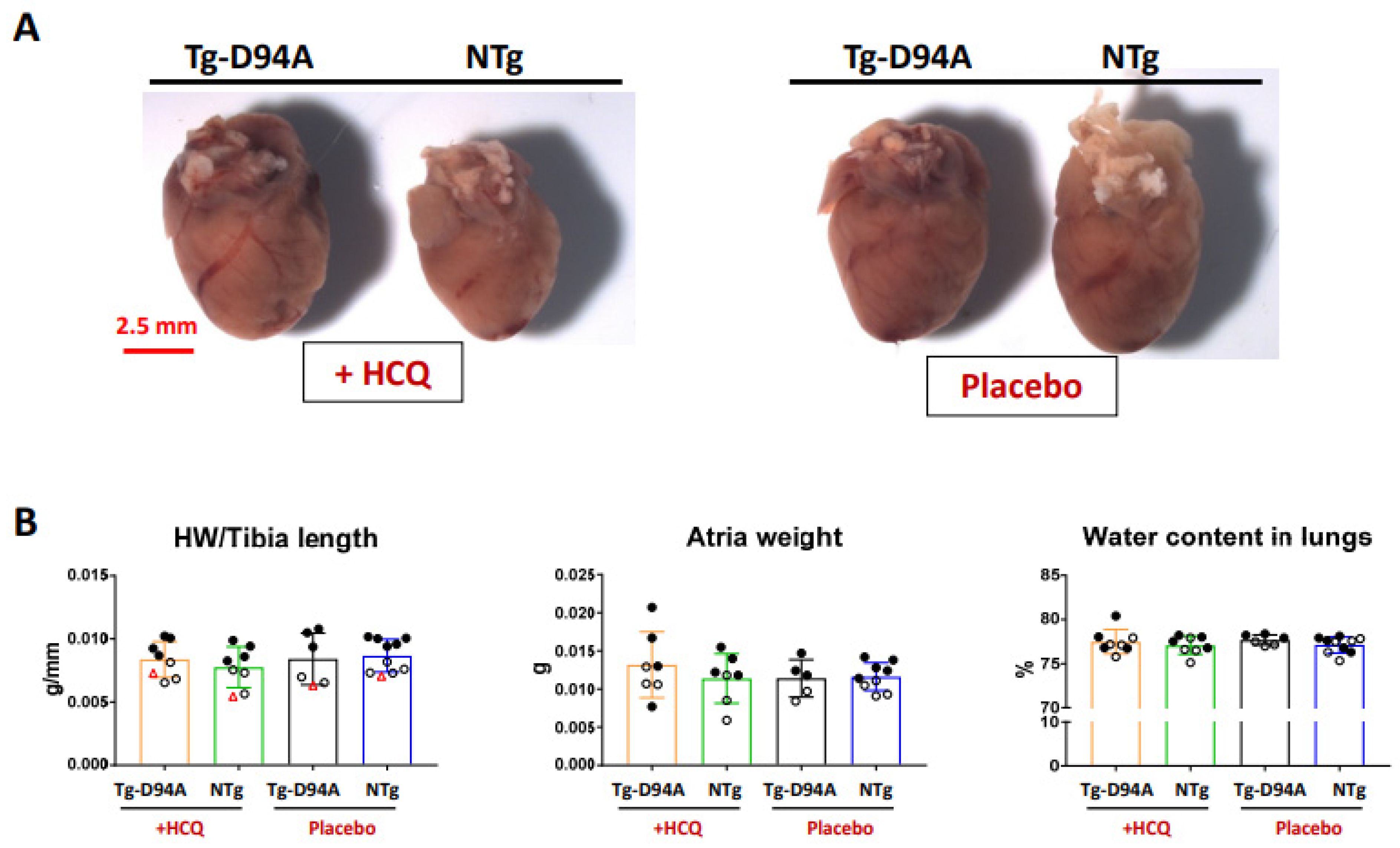
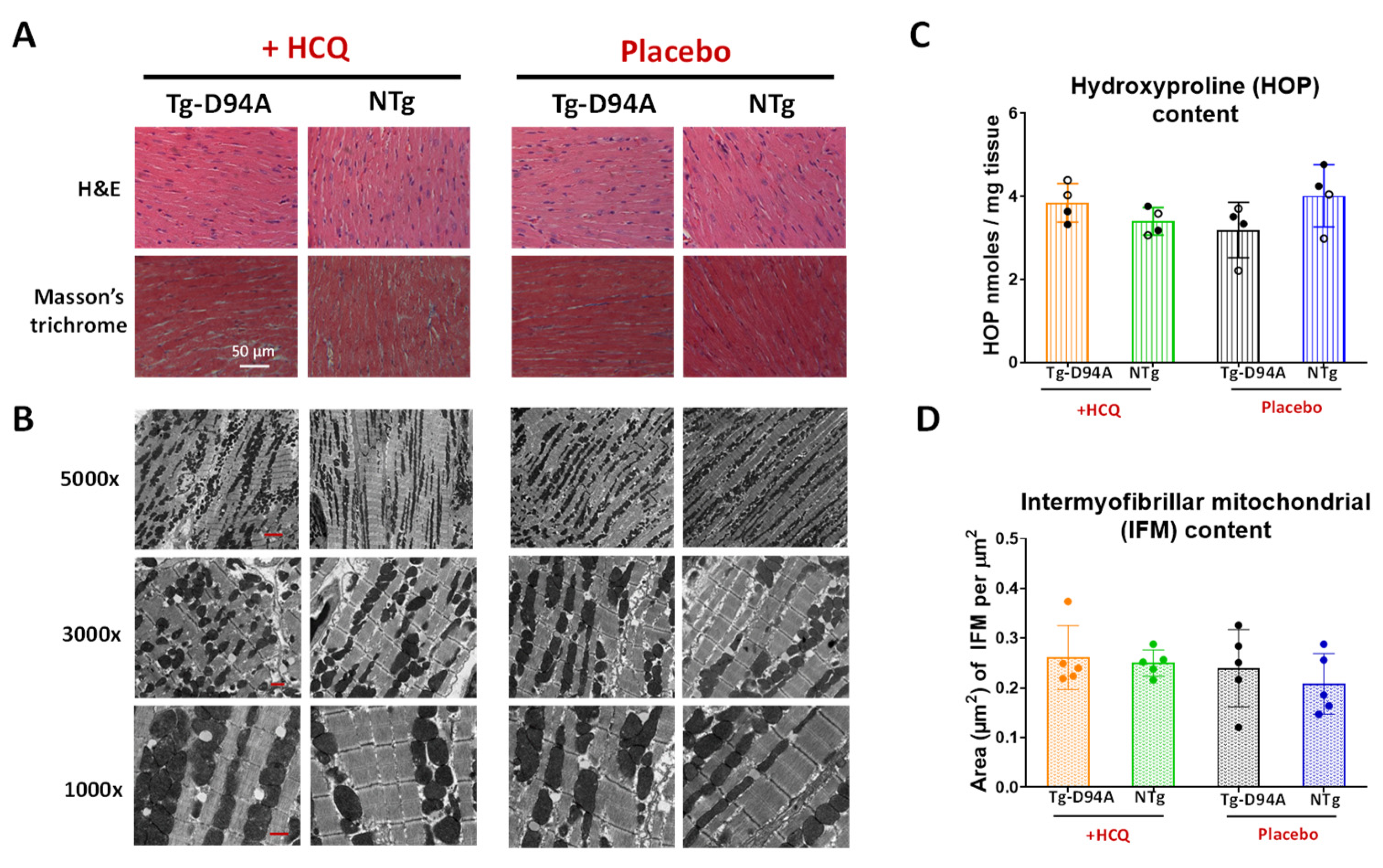
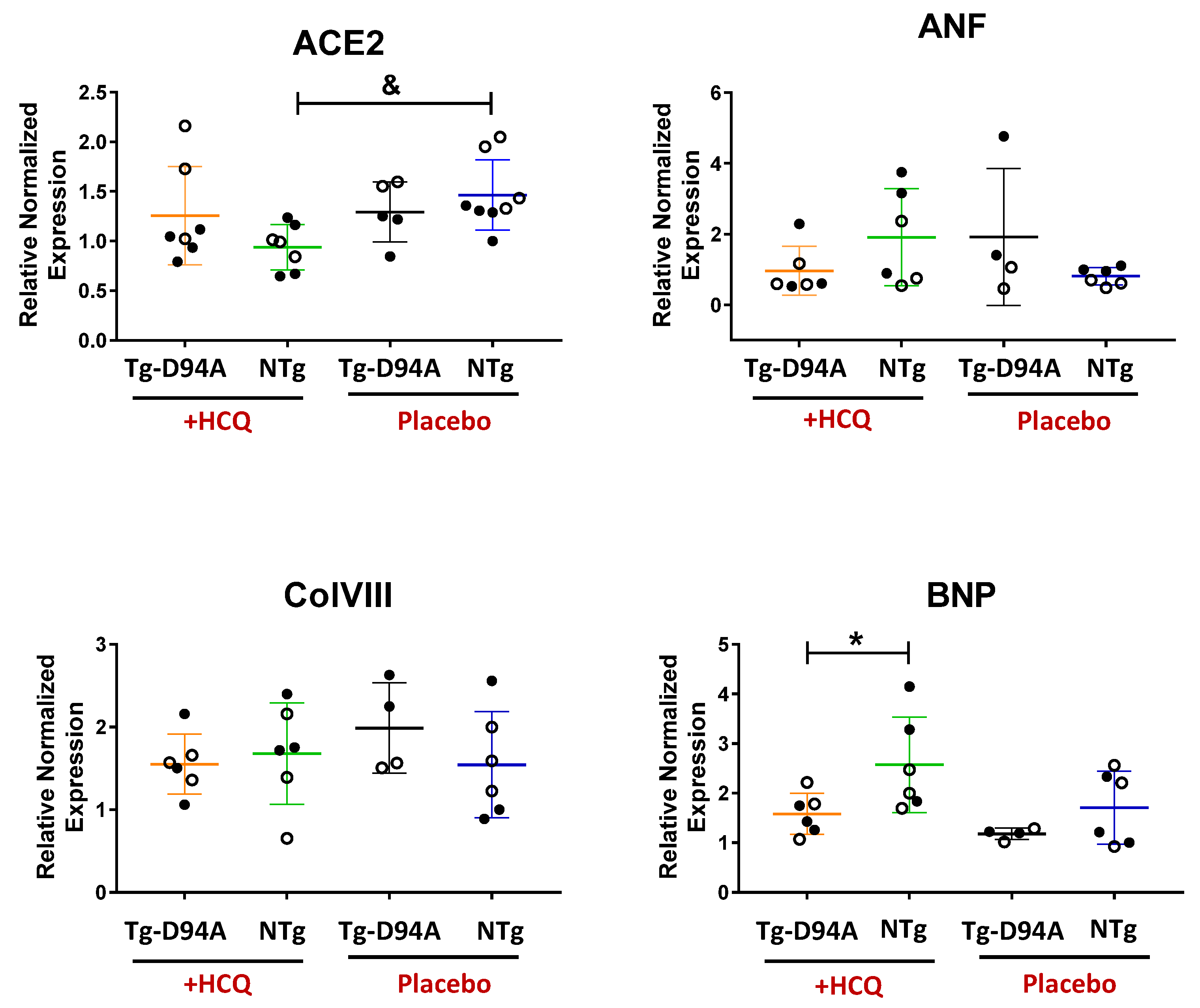
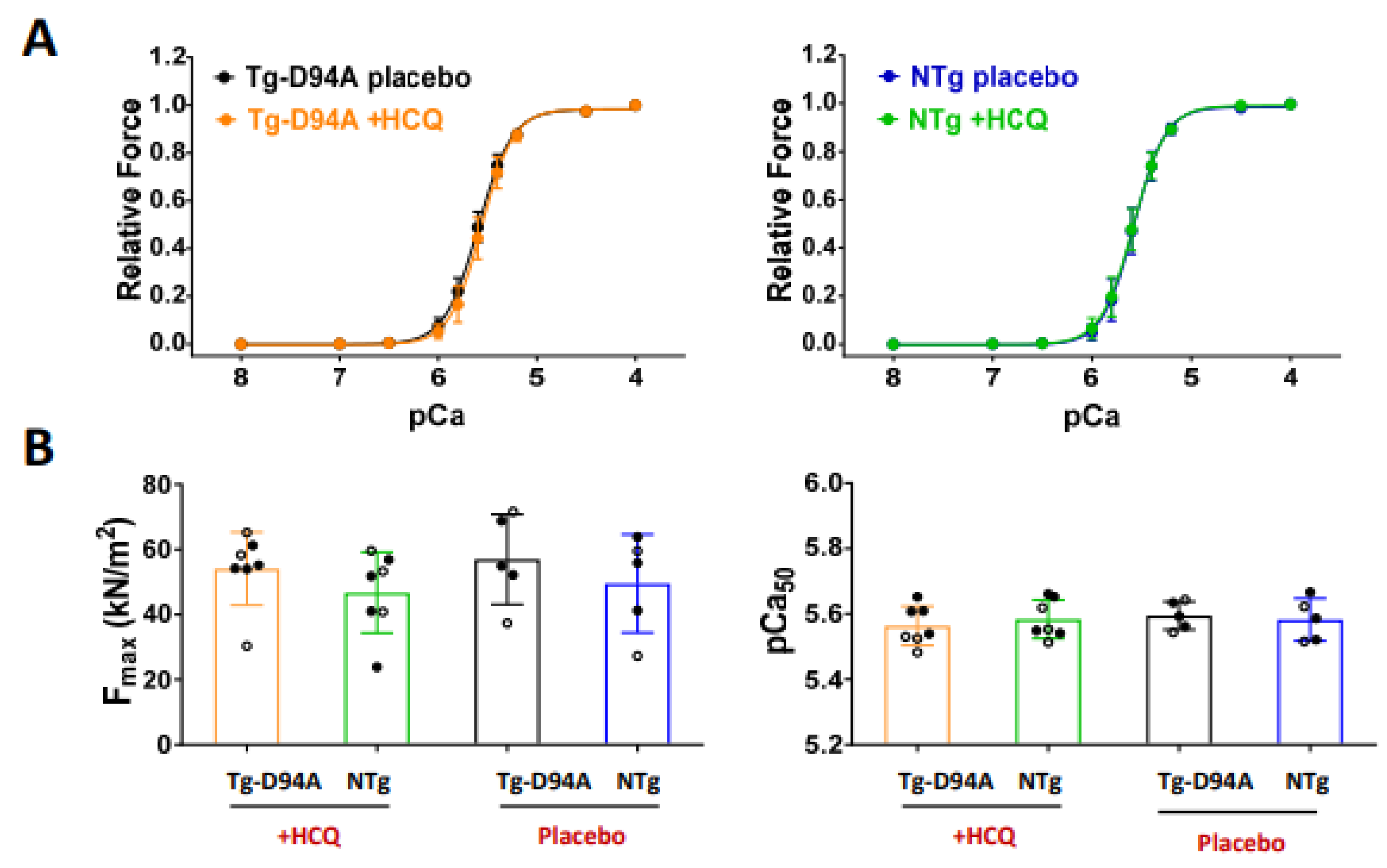
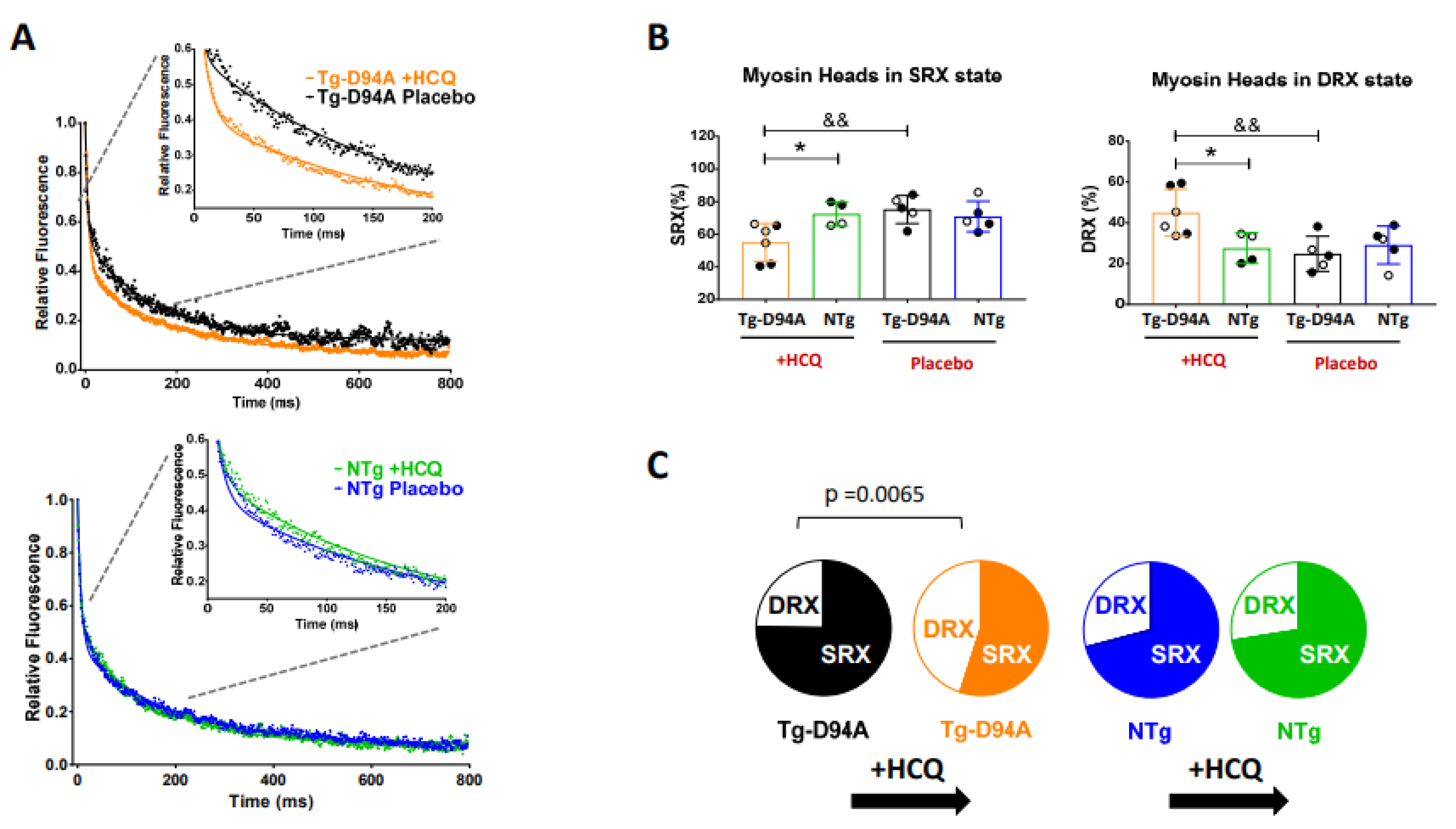
| BASELINE | DAY 30 | |||||
|---|---|---|---|---|---|---|
| HCQ | Placebo (H2O) | |||||
| Parameter | Tg-D94A | NTg | Tg-D94A | NTg | Tg-D94A | NTg |
| No of animals (M, F) | 13 (6, 7) | 13 (6, 7) | 8 (4, 4) | 8 (4, 4) | 6 (3, 3) | 10 (5, 5) |
| M-mode | ||||||
| HR (bpm) | 547 ± 11 | 538 ±13 | 534 ± 12.3 | 557 ± 13.0 | 543 ± 16.0 | 511 ± 10.3 |
| LVID; s (mm) | 2.8 ± 0.1 | 2.8 ± 0.1 | 2.9 ± 0.1 | 2.8 ± 0.1 | 2.9 ± 0.1 | 3.0 ± 0.1 |
| LVID; d (mm) | 4.0 ± 0.1 | 4.0 ± 0.1 | 4.0 ± 0.1 | 4.0 ± 0.1 | 4.1 ± 0.1 | 4.2 ± 0.1 |
| FS (%) | 29.4 ± 1.1 | 29.4 ± 0.9 | 28.3 ± 1.5 | 29.9 ± 1.3 | 29.5 ± 1.1 | 28.6 ± 1.1 |
| LV Mass (mg) | 107 ± 6.6 | 101 ± 6.4 | 107 ± 6.1 | 113 ± 10.0 | 116 ± 10.2 | 111 ± 10.7 |
| LVAW; s (mm) | 1.4 ± 0.04 | 1.3 ± 0.03 | 1.4 ± 0.07 | 1.4 ± 0.05 | 1.4 ± 0.03 | 1.3 ± 0.06 |
| LVAW; d (mm) | 0.9 ± 0.03 | 0.9 ± 0.04 | 0.9 ± 0.04 | 1.0 ± 0.04 | 0.9 ± 0.05 | 1.0 ± 0.06 |
| LVPW; s (mm) | 1.2 ± 0.03 | 1.1 ± 0.02 | 1.2 ± 0.03 | 1.2 ± 0.04 | 1.2 ± 0.05 | 1.1 ± 0.05 |
| LVPW; d (mm) | 0.8 ± 0.03 | 0.7 ± 0.02 | 0.8 ± 0.02 | 0.8 ± 0.05 | 0.9 ± 0.04 | 0.8 ± 0.03 |
| Anatomical M-mode | ||||||
| TAPSE (mm) | 0.7 ± 0.03 * | 0.8 ± 0.03 | 0.8 ± 0.03 ** | 0.7 ± 0.05 | 0.6 ± 0.03 | 0.7 ± 0.02 |
| B-mode | ||||||
| HR (bpm) | 534 ± 8.8 | 532 ± 9.6 | 543 ± 16.3 | 552 ± 11.8 | 536 ± 12.5 | 514 ± 14.1 |
| ESV (μL) | 23.7 ± 1.7 | 26.0 ± 1.9 | 26.1 ± 2.0 | 28.5 ± 2.3 | 25.9 ± 2.6 | 29.3 ± 2.1 |
| EDV (μL) | 53.5 ± 2.4 | 57.4 ± 3.3 | 56.4 ± 3.8 | 56.7 ± 4.5 | 56.6 ± 4.6 | 61.4 ± 3.1 |
| SV (μL) | 30 ± 1.2 | 31.5 ± 1.6 | 30.3 ± 1.9 | 30.4 ± 2.0 | 30.7 ± 2.2 | 32.1 ± 1.4 |
| EF (%) | 56 ± 1.7 | 55 ± 0.9 | 53.9 ± 0.8 | 54.2 ± 1.1 | 54.6 ± 1.4 | 52.6 ± 1.5 |
| CO (mL/min) | 15.9 ± 0.6 | 16.7 ± 0.9 | 16.4 ± 0.9 | 16.7 ± 0.9 | 16.5 ± 1.4 | 16.5 ± 0.8 |
| GLS (%) | −12.8 ± 0.5 ****†† | −17.9 ± 0.3 | −14.6 ± 0.5 ** | −17.9 ± 0.3 | −13.4 ± 1.3 ** | −17.6 ± 0.5 |
| HCQ | Placebo | |||
|---|---|---|---|---|
| Parameter | Tg-D94A | NTg | Tg-D94A | NTg |
| N° mice (M, F) N° fibers | 7 (4, 3) 16 | 7 (4, 3) 14 | 5 (3, 2) 10 | 5 (3, 2) 10 |
| Fmax (kN/m2) | 54.12 ± 4.25 | 46.78 ± 4.70 | 57.02 ± 6.19 | 49.57 ± 6.74 |
| pCa50 | 5.56 ± 0.02 | 5.58 ± 0.02 | 5.60 ± 0.02 | 5.58 ± 0.03 |
| nH | 2.80 ± 0.06 | 2.73 ± 0.08 | 2.60 ± 0.12 | 2.89 ± 0.07 |
| HCQ | Placebo | |||
|---|---|---|---|---|
| Parameter | Tg-D94A | NTg | Tg-D94A | NTg |
| No mice (M, F) No fibers | 6 (3, 3) 17 | 4 (2, 2) 11 | 5 (3, 2) 12 | 5 (3, 2) 16 |
| DRX (%) | 45 ± 5 &&, * | 28 ± 4 | 25 ± 4 | 29 ± 4 |
| SRX (%) | 55 ± 5 &&, * | 72 ± 4 | 75 ± 4 | 71 ± 4 |
| T1 (s) | 10 ± 3 | 8 ± 1 | 6 ± 2 | 5 ± 1 |
| T2 (s) | 240 ± 3 | 207 ± 4 | 231 ± 8 | 198 ± 2 |
Publisher’s Note: MDPI stays neutral with regard to jurisdictional claims in published maps and institutional affiliations. |
© 2022 by the authors. Licensee MDPI, Basel, Switzerland. This article is an open access article distributed under the terms and conditions of the Creative Commons Attribution (CC BY) license (https://creativecommons.org/licenses/by/4.0/).
Share and Cite
Kanashiro-Takeuchi, R.M.; Kazmierczak, K.; Liang, J.; Takeuchi, L.M.; Sitbon, Y.H.; Szczesna-Cordary, D. Hydroxychloroquine Mitigates Dilated Cardiomyopathy Phenotype in Transgenic D94A Mice. Int. J. Mol. Sci. 2022, 23, 15589. https://doi.org/10.3390/ijms232415589
Kanashiro-Takeuchi RM, Kazmierczak K, Liang J, Takeuchi LM, Sitbon YH, Szczesna-Cordary D. Hydroxychloroquine Mitigates Dilated Cardiomyopathy Phenotype in Transgenic D94A Mice. International Journal of Molecular Sciences. 2022; 23(24):15589. https://doi.org/10.3390/ijms232415589
Chicago/Turabian StyleKanashiro-Takeuchi, Rosemeire M., Katarzyna Kazmierczak, Jingsheng Liang, Lauro M. Takeuchi, Yoel H. Sitbon, and Danuta Szczesna-Cordary. 2022. "Hydroxychloroquine Mitigates Dilated Cardiomyopathy Phenotype in Transgenic D94A Mice" International Journal of Molecular Sciences 23, no. 24: 15589. https://doi.org/10.3390/ijms232415589
APA StyleKanashiro-Takeuchi, R. M., Kazmierczak, K., Liang, J., Takeuchi, L. M., Sitbon, Y. H., & Szczesna-Cordary, D. (2022). Hydroxychloroquine Mitigates Dilated Cardiomyopathy Phenotype in Transgenic D94A Mice. International Journal of Molecular Sciences, 23(24), 15589. https://doi.org/10.3390/ijms232415589






